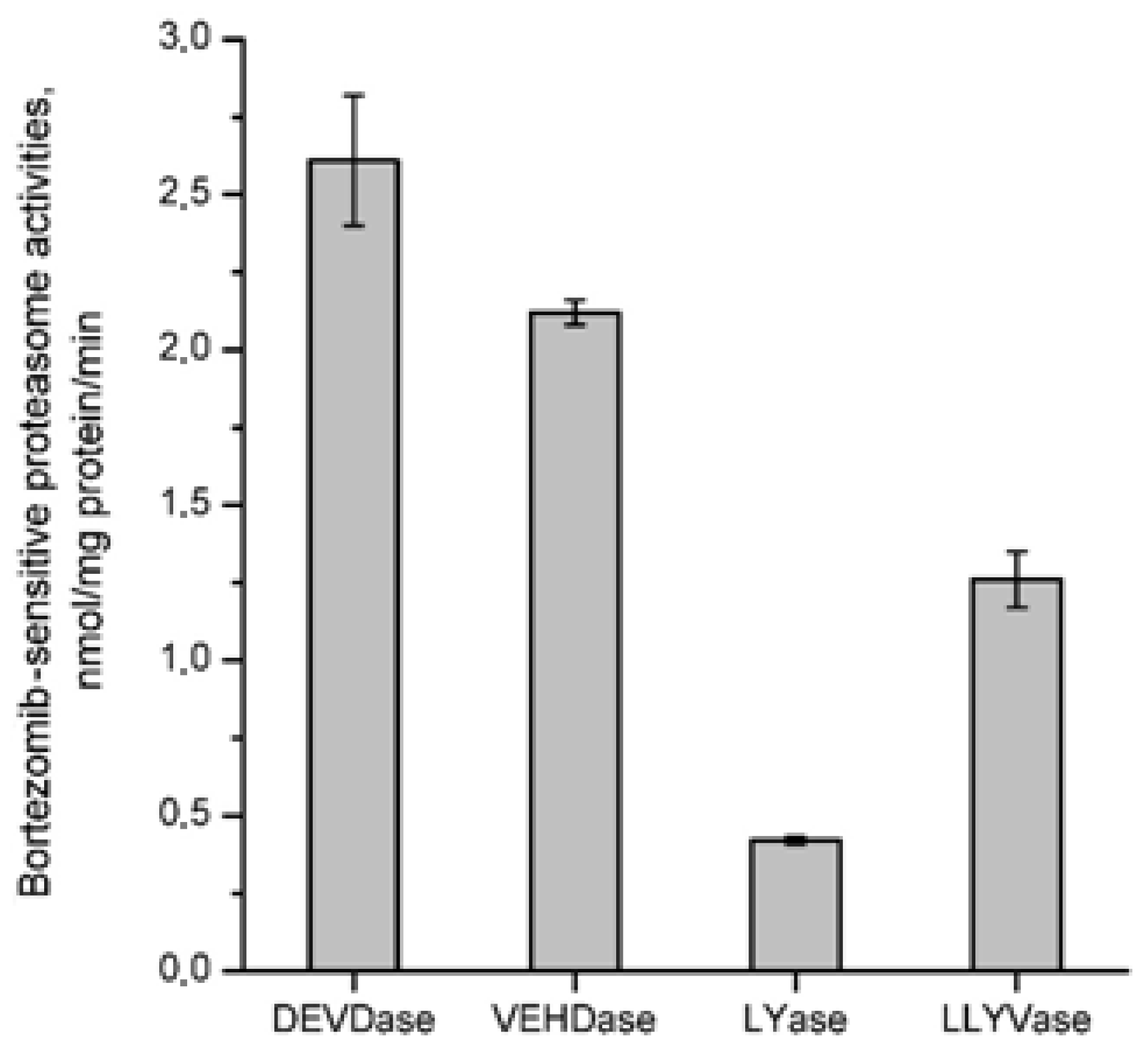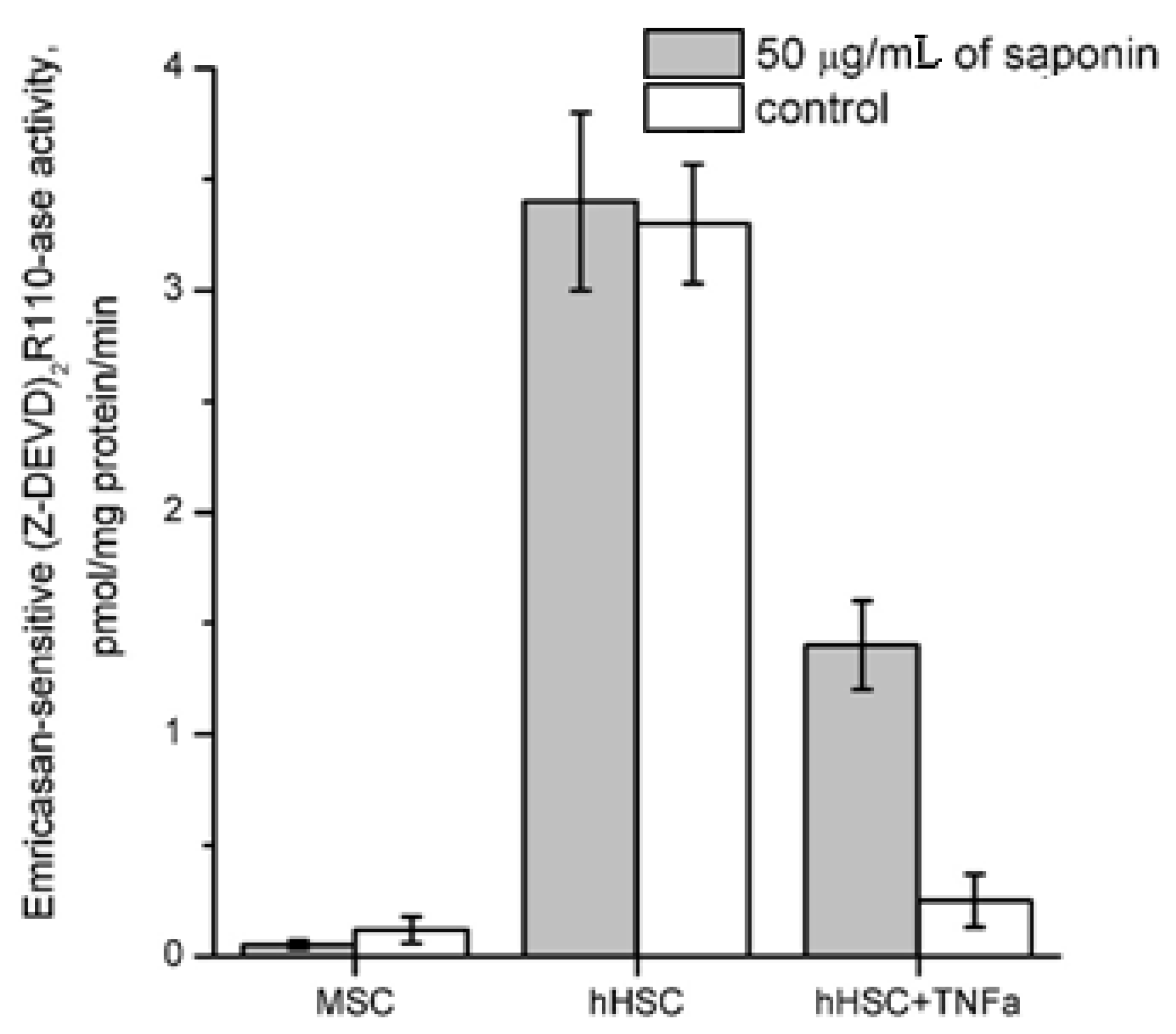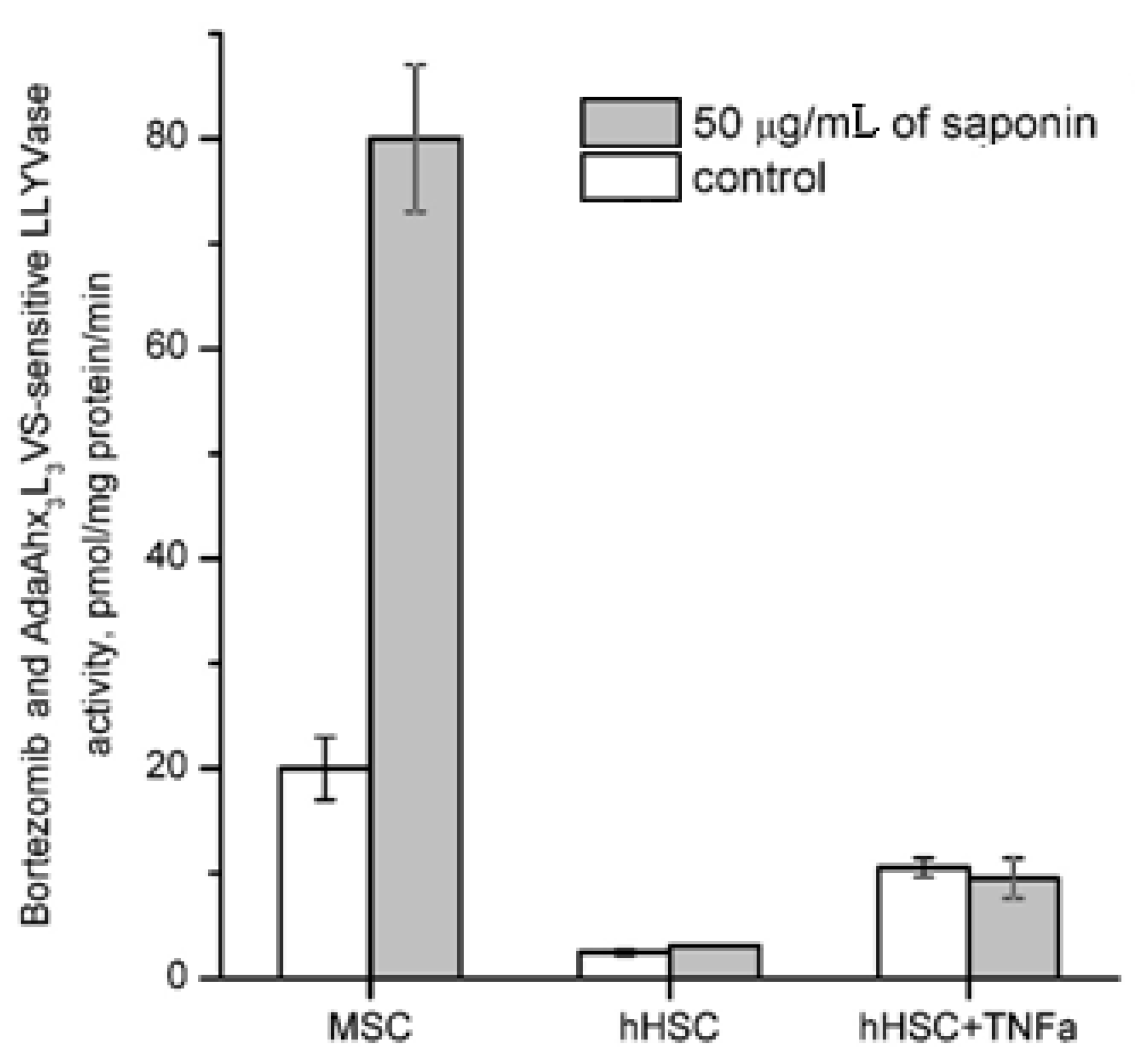Apoptosomes and Proteasomes from Exosomes Generated by Human Hematopoietic Stem Cells †
Abstract
1. Introduction
2. Experiments
3. Results
4. Discussion
Author Contributions
Institutional Review Board Statement
Informed Consent Statement
Data Availability Statement
Acknowledgments
Conflicts of Interest
Abbreviations
| HSC | hematopoietic stem cell |
| MSC | mesenchymal stem cell |
| TNFα | tumor necrosis factor α |
| PR3 | serine proteinase 3 |
| SERPINB1 | serine protease inhibitor B1 |
| MLKL | mixed lineage kinase domain-like protein |
| GSDMD | gasdermin D |
| SFEM | Serum-Free Expansion Medium |
| Flt3L | fms-related tyrosine kinase 3 ligand |
| SCF | stem cell factor |
| IL-2, -3, -6 | interleukine-2, -3, -6 |
| TPO | thrombopoietin |
| GM-CSF | granulocyte-macrophage colony-stimulating factor |
| (Z-DEVD)2R110 | Z-Asp-Glu-Val-Asp)2-Rhodamine 110 |
| AdaAhx3L3VS | Adamantane-acetyl-(6-aminohexanoyl)3-(leucinyl)3-vinyl-(methyl)-sulfone |
| Z-LLYV-AMC | Suc-Leu-Leu-Val-Tyr-7-amino-4-methylcoumarin |
References
- Prudnikov, I.M.; Tsyvkin, V.M.; Smirnov, A.M.; Pristash, L.V.; Chernyak, V.A.; Selyuk, V.M.; Muzichenko, P.F. Current comprehension of vesicular intercellular signaling. Fiziolohichnyĭ Zhurnal 2019, 65, 105–125. [Google Scholar] [CrossRef]
- Bochmann, I.; Ebstein, F.; Lehmann, A.; Wohlschlaeger, J.; Sixt, S.U.; Kloetzel, P.-M.; Dahlmann, B. T lymphocytes export proteasomes by way of microparticles: A possible mechanism for generation of extracellular proteasomes. J. Cell. Mol. Med. 2014, 18, 59–68. [Google Scholar] [CrossRef] [PubMed]
- Prudnikov, I.; Tsyvkin, V.; Smirnov, A.; Pristash, I.; Syrko, M. Extracellular Proteasomes. Fiziolohichnyĭ Zhurnal 2020, 66, 73–84. [Google Scholar] [CrossRef]
- Ravichandran, R.; Bansal, S.; Rahman, M.; Sharma, M.; Liu, M.; Bharat, A.; Hachem, B.; Omar, A.; Smith, M.A.; Mohanakumar, T. The role of donor-derived exosomes in lung allograft rejection. Hum. Immunol. 2019, 80, 588–594. [Google Scholar] [CrossRef] [PubMed]
- Kitajima, Y.; Suzuki, N.; Nunomiya, A.; Osana, S.; Yoshioka, K.; Tashiro, Y.; Takahashi, R.; Ono, Y.; Aoki, M.; Nagatomi, R. The Ubiquitin-Proteasome System Is Indispensable for the Maintenance of Muscle Stem Cells. Stem Cell Rep. 2018, 11, 1523–1538. [Google Scholar] [CrossRef]
- Shan, H.; Li, X.; Xiao, X.; Dai, Y.; Huang, J.; Song, J.; Liu, M.; Yang, L.; Lei, Y.; Tong, Y. USP7 deubiquitinates and stabilizes NOTCH1 in T-cell acute lymphoblastic leukemia. Signal Transduct. Target. Ther. 2018, 3, 29. [Google Scholar] [CrossRef]
- Suresh, B.; Lee, J.; Kim, H.; Ramakrishna, S. Regulation of pluripotency and differentiation by deubiquitinating enzymes. Cell Death Differ. 2016, 23, 1257–1264. [Google Scholar] [CrossRef]
- Hao, Q.; Chen, Y.; Zhou, X. The Janus Face of p53-Targeting Ubiquitin Ligases. Cells 2020, 9, 1656. [Google Scholar] [CrossRef]
- Crawford, E.D.; Wells, J.A. Caspase substrates and cellular remodeling. Annu. Rev. Biochem. 2011, 80, 1055–1087. [Google Scholar] [CrossRef]
- Tanzen, V.; Fleming, H.E.; Riedt, T.; Karlsson, G.; Riese, M.J.; Celso, L.C.; Reynolds, G.; Milne, G.D.; Paige, C.J.; Reynolds, G. Hematopoietic stem cell responsiveness to exogenous signals is limited by caspase-3. Cell Stem Cell 2008, 2, 584–594. [Google Scholar] [CrossRef]
- Wang, L.S.; Liu, H.J.; Xia, Z.B.; Broxmeyer, H.E.; Lu, L. Expression and activation of caspase-3/CPP32 in CD34+ cord blood cells is linked to apoptosis after growth factor withdrawal. Exp. Hematol. 2000, 28, 907–915. [Google Scholar] [CrossRef]
- Nonomura, K.; Yamaguchi, Y.; Hamachi, M.; Koike, M.; Uchiyama, Y.; Nakazato, K.; Mochizuki, A.; Sakaue-Sawano, A.; Miyawaki, A.; Yoshida, H. Local apoptosis modulates early mammalian brain development through the elimination of morphogen-producing cells. Dev. Cell 2013, 27, 621–634. [Google Scholar] [CrossRef] [PubMed]
- Ning, X.; Wang, Y.; Jing, M.; Sha, M.; Lv, M.; Gao, P.; Zhang, R.; Huang, X.; Feng, J.-M.; Jiang, Z. Apoptotic Caspases Suppress Type I Interferon Production via the Cleavage of cGAS, MAVS, and IRF3. Mol. Cell 2019, 74, 19–31. [Google Scholar] [CrossRef] [PubMed]
- Loison, F.; Xu, Y.; Luo, H.R. Proteinase 3 and Serpin B1: A novel pathway in the regulation of caspase-3 activation, neutrophil spontaneous apoptosis, and inflammation. Inflamm. Cell Signal. 2014, 1, e462. [Google Scholar] [CrossRef] [PubMed]
- Burgener, S.S.; Leborgne, N.G.F.; Snipas, S.J.; Salvesen, G.S.; Bird, P.I.; Benarafa, C. Cathepsin G Inhibition by Serpinb1 and Serpinb6 Prevents Programmed Necrosis in Neutrophils and Monocytes and Reduces GSDMD-Driven Inflammation. Cell Rep. 2019, 27, 3646–3656. [Google Scholar] [CrossRef]
- Cao, M.; Chen, F.; Xie, N.; Cao, M.-Y.; Chen, P.; Lou, Q.; Zhao, Y.; He, C.; Zhang, S.; Song, X.; et al. c-Jun N-terminal kinases differentially regulate TNF- and TLRs-mediated necroptosis through their kinase-dependent and -independent activities. Cell Death Dis. 2018, 9, 1–16. [Google Scholar] [CrossRef]
- Xiao, Y.; Li, H.; Zhang, J.; Wei, W.; Breslin, P.; Zhang, J. TNF-α/Fas-RIP-1-induced cell death signaling separates murine hematopoietic stem cells/progenitors into 2 distinct populations. Blood 2011, 118, 6057–6067. [Google Scholar] [CrossRef][Green Version]
- Murphy, J.M.; Czabotar, P.E.; Hildebrand, J.M.; Lucet, I.S.; Zhang, J.G.; Alvarez-Diaz, S.; Lewis, R.; Lalaoui, N.; Metcalf, D.; Webb, A.I. The pseudokinase MLKL mediates necroptosis via a molecular switch mechanism. Immunity 2013, 39, 443–453. [Google Scholar] [CrossRef]
- Samson, A.L.; Zhang, Y.; Geoghegan, N.D.; Gavin, X.J.; Davies, K.A.; Mlodzianoski, M.J.; Whitehead, L.W.; Frank, D.; Garnish, S.E.; Fitzgibbon, C.; et al. MLKL trafficking and accumulation at the plasma membrane control the kinetics and threshold for necroptosis. Nat. Commun. 2020, 11, 3151. [Google Scholar] [CrossRef]
- Miao, E.A.; Leaf, I.A.; Treuting, P.M.; Mao, D.P.; Dors, M.; Sarkar, A.; Warren, S.E.; Wewers, M.D.; Aderem, A. Caspase-1-induced pyroptosis is an innate immune effector mechanism against intracellular bacteria. Nat. Immunol. 2010, 11, 1136–1142. [Google Scholar] [CrossRef]
- Kayagaki, N.; Stowe, I.B.; Lee, B.L.; O’Rourke, K.; Anderson, K.; Warming, S.; Cuellar, T.; Haley, B.; Roose-Girma, M.; Phung, Q.T.; et al. Caspase-11 cleaves gasdermin D for non-canonical inflammasome signaling. Nature 2015, 526, 666–671. [Google Scholar] [CrossRef] [PubMed]
- Kedong, S.; Fan., X.; Liu, T.; Macedo, H.M.; Jiang, L.; Fang, M.; Shi, F.; Ma, X.; Cui, Z. Simultaneous expansion and harvest of hematopoietic stem cells and mesenchymal stem cells derived from umbilical cord blood. J. Mater. Sci. Mater. Med. 2010, 21, 3183–3193. [Google Scholar] [CrossRef]
- Prudnikov, I.M.; Smirnov, A.N. Short peptide tools for monitoring caspase and proteasome activities in embryonal and adult rat brain lysates: An approach for the differential identification of proteases. J. Biochem. 2012, 151, 299–316. [Google Scholar] [CrossRef] [PubMed]
- Batsali, A.K.; Georgopoulou, A.; Mavroudi, I.; Matheakakis, A.; Pontikoglou, C.G.; Papadaki, H.A. The Role of Bone Marrow Mesenchymal Stem Cell Derived Extracellular Vesicles (MSC-EVs) in Normal and Abnormal Hematopoiesis and Their Therapeutic Potential. J. Clin. Med. 2020, 9, 856. [Google Scholar] [CrossRef]
- Singh, R.; Letai, A.; Sarosiek, K. Regulation of apoptosis in health and disease: The balancing act of BCL-2 family proteins. Nat. Rev. Mol. Cell Biol. 2019, 20, 175–193. [Google Scholar] [CrossRef] [PubMed]
- White, M.J.; McArthur, K.; Metcalf, D.; Lane, R.M.; Cambier, J.C.; Herold, M.J.; van Delft, M.F.; Bedoui, S.; Lessene, G.; Ritchie, M.E.; et al. Apoptotic Caspases Suppress mtDNA-Induced STING-Mediated Type I IFN Production. Cell 2014, 159, 1549–1562. [Google Scholar] [CrossRef]
- Lai, R.C.; Tan, S.S.; Teh, B.J.; Sze, S.K.; Arslan, F.; De Kleijn, D.P.; Choo, A.; Lim, S.K. Proteolytic Potential of the MSC Exosome Proteome: Implications for an Exosome-Mediated Delivery of Therapeutic Proteasome. Int. J. Proteom. 2012, 2012, 1–14. [Google Scholar] [CrossRef]
- Zoeger, A.; Blau, M.; Egerer, K.; Feist, E.; Dahlmann, B. Circulating Proteasomes Are Functional and Have a Subtype Pattern Distinct from 20S Proteasomes in Major Blood Cells. Clin. Chem. 2006, 52, 2079–2086. [Google Scholar] [CrossRef]
- Tsimokha, A.S.; Zaykova, J.J.; Bottrill, A.; Barlev, N.A. Extracellular Proteasomes Are Deficient in 19S Subunits as Revealed by iTRAQ Quantitative Proteomics. J. Cell. Physiol. 2017, 232, 842–851. [Google Scholar] [CrossRef]
- Ramachandran, K.V.; Fu, J.M.; Schaffer, T.B.; Na, C.H.; Delannoy, M.; Margolis, S.S. Activity-Dependent Degradation of the Nascentome by the Neuronal Membrane Proteasome. Mol. Cell 2018, 71, 169–177. [Google Scholar] [CrossRef]
- Dong, T.; Liao, D.; Liu, X.; Lei, X. Using Small Molecules to Dissect Non-apoptotic Programmed Cell Death: Necroptosis, Ferroptosis, and Pyroptosis. Chembiochem 2015, 16, 2557–2561. [Google Scholar] [CrossRef] [PubMed]
- Luo, H.R.; Am, F.L. Constitutive neutrophil apoptosis: Mechanisms and regulation. J. Hematol. 2008, 83, 288–295. [Google Scholar] [CrossRef] [PubMed]
- Scheel-Toellner, D.; Wang, K.-Q.; Webb, P.R.; Wong, S.H.; Craddock, R.; Assi, L.K.; Salmon, M.; Lord, J.M. Early events in spontaneous neutrophil apoptosis. Biochem. Soc. Trans. 2004, 32, 461–464. [Google Scholar] [CrossRef] [PubMed]
- Tang, R.; Xu, J.; Zhang, B.; Liu, J.; Liang, C.; Hua, J.; Meng, Q.; Yu, X.; Shi, S. Ferroptosis, necroptosis, and pyroptosis in anticancer immunity. J. Hematol. Oncol. 2020, 13, 110. [Google Scholar] [CrossRef] [PubMed]




Publisher’s Note: MDPI stays neutral with regard to jurisdictional claims in published maps and institutional affiliations. |
© 2020 by the authors. Licensee MDPI, Basel, Switzerland. This article is an open access article distributed under the terms and conditions of the Creative Commons Attribution (CC BY) license (https://creativecommons.org/licenses/by/4.0/).
Share and Cite
Prudnikov, I.; Smirnov, A.; Tsyvkin, V. Apoptosomes and Proteasomes from Exosomes Generated by Human Hematopoietic Stem Cells. Proceedings 2021, 75, 2. https://doi.org/10.3390/Cells2020-08924
Prudnikov I, Smirnov A, Tsyvkin V. Apoptosomes and Proteasomes from Exosomes Generated by Human Hematopoietic Stem Cells. Proceedings. 2021; 75(1):2. https://doi.org/10.3390/Cells2020-08924
Chicago/Turabian StylePrudnikov, Igor, Anton Smirnov, and Volodymyr Tsyvkin. 2021. "Apoptosomes and Proteasomes from Exosomes Generated by Human Hematopoietic Stem Cells" Proceedings 75, no. 1: 2. https://doi.org/10.3390/Cells2020-08924
APA StylePrudnikov, I., Smirnov, A., & Tsyvkin, V. (2021). Apoptosomes and Proteasomes from Exosomes Generated by Human Hematopoietic Stem Cells. Proceedings, 75(1), 2. https://doi.org/10.3390/Cells2020-08924



